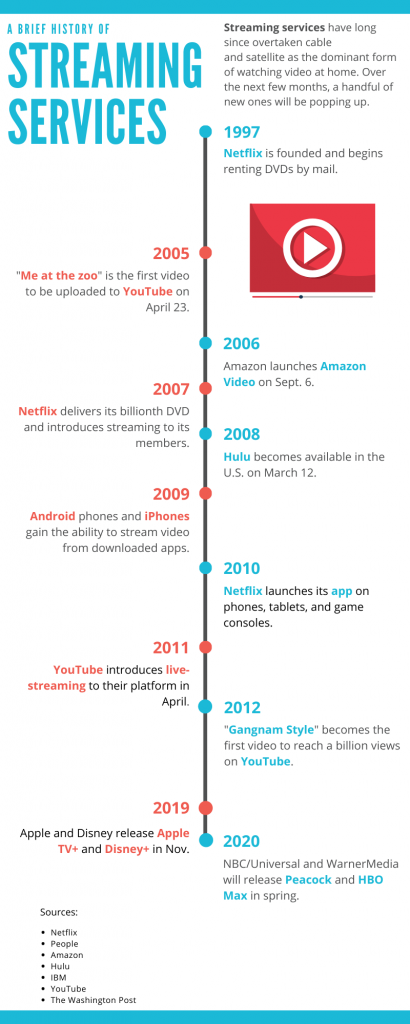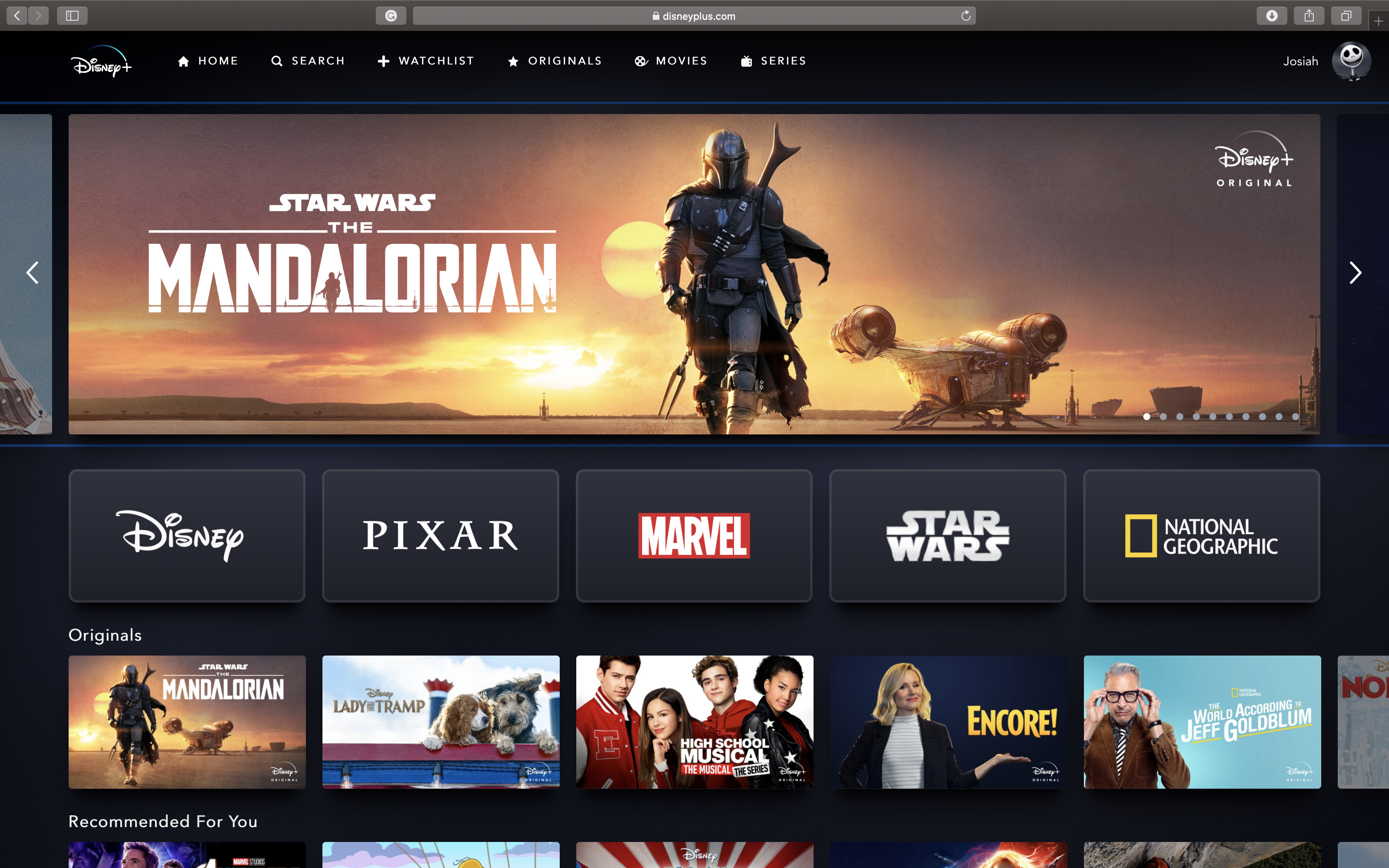Whether it’s on your TV, your computer, a tablet or a phone, streaming movies and shows has become a popular pastime over the past decade and a half. Streaming has come a long way from its infancy when YouTube was just a budding video sharing platform, even further if you take into consideration that Netflix started by renting DVDs by mail in 1997. Today, we can watch high-definition video in the palm of our hands.
Streaming video online has been a major blow to traditional cable and satellite telecommunication companies as streaming video has been more and more accessible. The strategy that the telecommunication companies have used to compete against companies like Netflix has gone from beating them to joining them, as companies have been merging with production studios over the past few years. Over the next few months, a handful of new streaming services will be released, including a couple from telecommunication companies, that could change the landscape of the current streaming market in major ways. This is what catches the attention of John Soloski, a professor of journalism at the University of Georgia.
What’s interesting is where they all are going, as far as competing against one another,” Soloski said.
“The consolidation is pretty much a done deal, but you look at streaming, and streaming is where the big battle is now because you have a bunch of companies that are after Netflix and want to cut into Netflix’s huge profits. And you have companies that have historically not been into any type of media content generation,” said Soloski.
Coming Soon to a Screen Near You
Disney+ launched this week at a starting price of $6.99 per month, making it the second major streaming service to release this year. The service opened the majority of the legendary “Disney vault” to its consumers, with a few notable exceptions such as 1946’s “Song of the South” (the movie the popular Disney World ride, Splash Mountain, is based on) and the original cut of “Dumbo” (an edited version of the 1940 film is available to stream with the removal of the infamous characters forming the Jim Crow Band). Disney+ also features content from the other properties residing in the House of Mouse with the most notable being from Lucasfilm’s Star Wars, Marvel Studios, Pixar, and National Geographic. The service features content from its most recent acquisition, 20th Century Fox, including 30 seasons of “The Simpsons.” An extensive Twitter thread detailing each of the hundreds of titles available at launch was recently posted on the Disney+ account. A major distinction that Disney+ has against services like Netflix and Hulu, is that the content added to Disney+ will become a part of a “permanent library” instead of titles rotating on and off the site.
Increased competition in the streaming industry kicked off this month and will continue over the next few months, as Disney+ is only one of many streaming services releasing in the near future.
Apple released its streaming service, aptly named Apple TV+, on Nov. 1. It costs $4.99 per month, but it is solely relying on original content because Apple, unlike Disney, has no back catalog of content to pull from. The quality of its original content will determine the fate of the streaming service as the company has invested over $6 billion into original programming.
NBC/Universal is launching its service, Peacock, in April and will house content from studios and networks owned by the conglomerate such as DreamWorks, NBC, and USA Network and Telemundo. Notable content that will be available on Peacock will include “The Office,” “Parks and Recreation,” “Brooklyn Nine-Nine,” “Saturday Night Live” and “The Fast and the Furious” franchise. “The Office” is currently one of the most popular shows on Netflix, so it’ll be worth seeing how the consumers react when the comedy moves to Peacock. Prices for Peacock have not been announced; however, there will be ad-supported and ad-free tiers.
Also launching in 2020, WarnerMedia will be expanding upon their HBO streaming brand with HBO Max. HBO Max will combine HBO’s content with the addition of the plethora of shows and movies owned by WarnerMedia’s studios and networks such as Cartoon Network, The CW and Warner Bros. Friends, the most popular show on Netflix, will be moving over to HBO Max when it launches. HBO Max also holds the exclusive U.S. streaming rights to BBC content as well as the Japanese animation company, Studio Ghibli, which is known for award-winning films such as “My Neighbor Totoro,” “Howl’s Moving Castle” and “Spirited Away.”
It was recently announced that HBO Max would be releasing in May 2020 at a starting subscription price of $14.99 per month. This will rank it among the high end of the pricing scale as the proposed price is creeping close to the prices of the premium tiers of other streaming services. Netflix’s premium plan, for example, currently costs $15.99 per month which grants the consumer the ability to stream at a resolution of 4K with high-dynamic range (HDR) and the amount of simultaneous screens streaming the service jumps up to four.
‘Be Kind, Rewind’
Streaming services trace their roots back to April 23, 2005, when “Me at the zoo” became the first video ever uploaded to YouTube. It wasn’t until 2007 the online DVD rental company, Netflix would release its streaming service.
Netflix, as well as other streaming companies that popped up over the next decade or so, began to be a direct competitor to cable and satellite TV providers like Comcast and DirecTV. Instead of paying for hundreds of channels, most of which go unused, in a bundle, consumers could pay as little as $8 a month to access a large selection of movies and shows that were available whenever they wanted to watch them.
The key strategy for the telecommunication companies has been to split up markets between them so that most markets around the country would only have access to one provider for TV, home phone and internet services. These local monopolies gave telecommunication companies free rein to set the prices of their services as high as they wanted.
The advent of video streaming services like Netflix made telecommunication companies rely on selling internet access as the primary source of income. Companies would feel the impact of the streaming explosion, so they came up with other ways of offsetting the blow. The primary way telecommunication companies started fighting back against the streaming industry was borrowing the usage of data caps from mobile phone providers like AT&T and Verizon. These data caps were put in place to encourage customers to use their cable and satellite TV services instead of streaming; however, it mostly just caused customers to pay extra fees instead.
The telecommunication companies’ newest approach to competing with streaming services is to merge with production studios and create their streaming services.
For example, AT&T and Time Warner successfully merged into WarnerMedia in 2018 after two years of appeals in court. The marriage of these two corporations gives AT&T access to both the content that consumers are streaming as well as continuing to be the point of access to the internet.
These new subscription services will have impacts on existing streaming platforms and consumers in similar ways. “Friends” and “The Office” are currently the two most viewed shows on Netflix. Now that those shows are relocating to other streaming services, Netflix is going to need something to fill that void, and the viewers of those shows are going to have to decide whether to subscribe to Peacock and HBO Max or to lose access to their favorite shows. Netflix is betting big on “Seinfeld” to attract the same fans as those two shows, as it made a roughly $100 million deal for the worldwide exclusive rights to stream it starting in 2021.
Streaming Habits
Consumers, on the other hand, are going to have to weigh the costs of these platforms with the value they hold, which is different from person-to-person or household-to-household.
Alex Trammell and Abuzar Turabi, both graduate students at the University of Georgia, have pretty similar tastes in what they watch.
“Mostly sports,” says Trammell.
“Yeah, like 90% of what I watch is sports-related,” says Turabi. “And then, I’ll occasionally watch like a comedy or some action. Just depends on the mood.”
When they aren’t watching sports, Trammell and Turabi usually focus on shows that have been recommended by other people, but they also have comfort food shows to fall back on like “The Office.”
One popular way that college-age streamers offset the cost of using multiple services is by sharing accounts with friends and family members.
“I usually use my sister’s [accounts], because she has a dog, so she can pay more than I can,” said Trammell.
“I usually find ways to use other people’s [accounts],” stated Turabi.
“I try not to pay, or, if it’s like my friends, I’m like, you know, can I use your [login] ID?” said Trammell with a laugh.
Maria and Reynaldo Caban, however, live with their youngest two children, Rey, a freshman in high school, and Ethan, who is in Kindergarten. Streaming is a big part of the family’s daily routine.
“I am a streaming crazy lady,” said Maria, “so, I do a lot of streaming.”
Maria is a stay-at-home mom and likes to have something on while Rey and Ethan are at school. After school, the kids spend around three to four hours streaming each.
“Ethan, as soon as he walks in the door from school, he takes off his shoes and it’s TV,” said Maria.
Reynaldo prefers to stream on the go.
“I deliver building supplies for the company Beacon,” said Reynaldo. “We deliver everything on this side of the state, and I do stream. We deliver, and I’ll usually stop for between 20 and 30 minutes, and I do stream while I wait, especially when I’m stopped for hours and hours, so I’ll watch a show or two.”
Who Will Get Renewed for Another Season?
At the end of the day, it’ll be you, the consumer, who will decide which of these platforms will be successful or not. Consumers are going to have to decide what they value in a streaming service and how many they can afford. Adding up the cost of these four new services plus the big three: Netflix, Hulu (premium, commercial-free plan), and Amazon Prime Video sum up over $60. That’s well on the way to a cable bill.
The Caban family is only looking to add Disney+ to their list, which currently consists of Netflix Amazon Prime Video, Vudu, and Tubi (the latter two services are free).
“Yeah, I want to see ‘The Mandalorian.’ That’s how I know that they had a channel,” said Reynaldo.
“Yeah, plus we got kids,” added Maria.
Anything can happen during the next phase of the streaming wars. The bubble might eventually burst as more and more companies pop up with new services, but it will be interesting to see what that will look like. Some companies might drop completely, while others may consume others to expand their library of content. As exclusive content spreads across more and more streaming services, piracy could become an even larger thorn in the side of these services than it already is as well. Only time will tell what services will survive.
Josiah Byler is a senior majoring in journalism in the Grady College of Journalism and Mass Communication at the University of Georgia.








Show Comments (0)